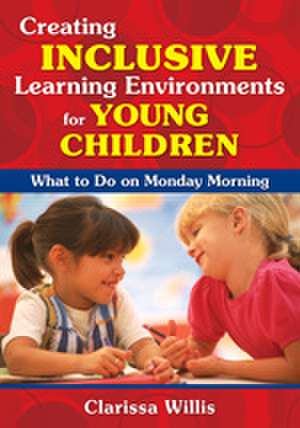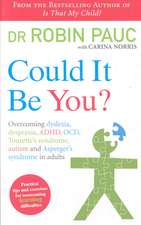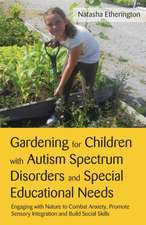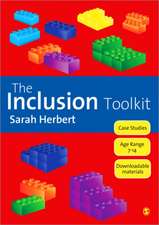Creating Inclusive Learning Environments for Young Children: What to Do on Monday Morning
Autor Clarissa Willisen Limba Engleză Paperback – 17 sep 2008
| Toate formatele și edițiile | Preț | Express |
|---|---|---|
| Paperback (1) | 286.47 lei 43-57 zile | |
| SAGE Publications – 17 sep 2008 | 286.47 lei 43-57 zile | |
| Hardback (1) | 513.36 lei 43-57 zile | |
| SAGE Publications – 17 sep 2008 | 513.36 lei 43-57 zile |
Preț: 286.47 lei
Nou
Puncte Express: 430
Preț estimativ în valută:
54.82€ • 57.38$ • 45.62£
54.82€ • 57.38$ • 45.62£
Carte tipărită la comandă
Livrare economică 31 martie-14 aprilie
Preluare comenzi: 021 569.72.76
Specificații
ISBN-13: 9781412957199
ISBN-10: 1412957192
Pagini: 240
Dimensiuni: 178 x 254 x 18 mm
Greutate: 0.5 kg
Ediția:1
Editura: SAGE Publications
Colecția Corwin
Locul publicării:Thousand Oaks, United States
ISBN-10: 1412957192
Pagini: 240
Dimensiuni: 178 x 254 x 18 mm
Greutate: 0.5 kg
Ediția:1
Editura: SAGE Publications
Colecția Corwin
Locul publicării:Thousand Oaks, United States
Recenzii
"Invites teachers to apply appropriate strategies in classroom environments for young children with special needs, setting the stage for future school success!”
“A blend of theory, research, and best practices, wrapped up with a bow that celebrates the diversity of our children with special needs. This book helps teachers better understand specific disabilities and intentional support mechanisms that encourage ALL children to learn and grow in inclusive early childhood environments. It is a resource that I will use for years to come!"
“A blend of theory, research, and best practices, wrapped up with a bow that celebrates the diversity of our children with special needs. This book helps teachers better understand specific disabilities and intentional support mechanisms that encourage ALL children to learn and grow in inclusive early childhood environments. It is a resource that I will use for years to come!"
Cuprins
Acknowledgments
About the Author
Introduction
Part I. Children With Special Needs in the Inclusive Classroom
1. Working With Children With Special Needs
What Do I Need to Know to Work With Children With Special Needs?
Setting the Stage for Inclusion
Inclusion, Blending, and Reverse Mainstreaming
Why Is Inclusion Important?
What Is "Meaningful" Inclusion?
How Do I Develop a Philosophy of Meaningful Inclusion?
General Strategies for Working With Children With Special Needs
How Do I Get the Child's Family Involved?
Resources for Families
Working to "Enable" and "Empower" Families
Terms Used in This Chapter
Resources Used in This Chapter
Suggested Reading
The Research Says...Developmentally Appropriate Practices Must Apply to Everyone
2. Blending the World of Special Education With General Education Services
Best Practices According to NAEYC and DEC
Constructivism vs. Behaviorism: Blending Without Ignoring Best Practice
Using Observation Skills to Guide Instruction
Planning for an IEP Meeting
The Teacher's Rules of the Road
Related Services
The Role of the Special Education Teacher
Working With Paraprofessionals and Instructional Assistants
Terms Used in This Chapter
Resources Used in This Chapter
Suggested Reading
The Research Says...What Early Childhood Practitioners Think About Inclusion
Part II. Who Are the Children With Special Needs?
3. Children With Vision Impairments
How Do Young Children Develop Vision?
What Causes Visual Impairments in Young Children?
How Are Vision Impairments Classified?
What Resources Are Available to Help the Child Function in My Classroom?
How Do Children With Vision Impairments Learn?
Preparing the Early Childhood Environment
Suggestions for Children With Low Vision
Suggestions for Children Who Are Blind or Severely Vision Impaired
Summary
Terms Used in This Chapter
Resources Used in This Chapter
Suggested Reading
The Research Says...Play Behaviors in Young Children Who Are Blind
4. Children With Hearing Loss
Defining Hearing Loss
What Determines the Degree of Hearing Loss?
So, What About Hearing Aids?
Cochlear Implant
How Will Hearing Loss Affect Children in My Classroom?
Social Isolation
Effects of Hearing Loss on Speech (Oral Language)
Reduced Academic Achievement
Suggestions for the Classroom
Terms Used in This Chapter
Resources Used in This Chapter
Suggested Reading
The Research Says...Cochlear Implants Can Result in Better Prosody
5. Children With Cognitive Challenges
Understanding the Challenges for Children With Cognitive Delays
Characteristics of Children With Cognitive Challenges
Educational Implications
What Are Functional Skills and Why Are They Important?
How Do I Teach Everyday Tasks (Functional Skills)?
What Do I Do First, Before Teaching a New Skill?
How Exactly Does This All Fit Together?
Classroom Suggestions for Children With Cognitive Challenges
Summary
Terms Used in This Chapter
Resources Used in This Chapter
Suggested Reading
The Research Says...Social Development Across Time
6. Children With Atypical Motor Development
Causes of Atypical Motor Development
Muscle Tone
Cerebral Palsy
Fine and Gross Motor Skills
Positioning and Handling
Adaptive Equipment
Summary
Terms Used in This Chapter
Resources Used in This Chapter
Suggested Reading
The Research Says...Children With Motor Delays Are At-Risk for Social Isolation
7. Children With Communication Delays
What Is Communication?
Understanding the Child's "Form" of Communication
Function and Content of Communication
The Nonverbal Child
Cleft Lip and Palate
Childhood Apraxia of Speech (CAS)
Terms Used in This Chapter
Resources Used in This Chapter
Suggested Reading
The Research Says...Communication Is More Than Just Imitation
8. Children With Emotional/Behavior Disorders
What Are Challenging Behaviors?
Young Children and Mental Health
Anxiety Disorders
Classroom Suggestions for Children with Anxiety Disorders
Separation Anxiety
Classroom Suggestions for Children With Separation Anxiety
Post-Traumatic Stress Disorder (PTSD)
Classroom Suggestions for Children With PTSD
Oppositional Defiant Disorder (ODD)
Classroom Suggestions for Children With ODD
Attention Deficit/Hyperactivity Disorder (ADHD)
Medication Issues
Classroom Suggestions for Children With ADHD
Summary
Terms Used in This Chapter
Resources Used in This Chapter
Suggested Reading
The Research Says...Risk Factors for Future Challenging Behaviors
9. Children With Autism Spectrum Disorder (ASD)
What Is a Spectrum Disorder?
What Is Autism?
What Are the Five Types of Autism?
Begin by Looking at the Child's Behavior
Communication Issues
Developing Social Skills
Summary
Terms Used in This Chapter
Resources Used in This Chapter
Suggested Reading
The Research Says...The Role of Attention and Intention in Learning New Words
10. Children With Sensory Integration Disorder
What Exactly Is Sensory Integration?
Sensory Integration Disorder
What Can I Do to Make My Classroom Sensory "Friendly"?
Materials for the "Sensory Friendly" Classroom
Terms Used in This Chapter
Resources Used in This Chapter
Suggested Reading
The Research Says...Trauma and Sensory Modulation Disorder
11. Children At Risk for School Failure
Who Are Children At Risk?
Children Living in Extreme Poverty
Homelessness
Family Factors
Chronic Illness
Future Learning Disability
Classroom Suggestions for Children At Risk
Terms Used in This Chapter
Resources Used in This Chapter
Suggested Reading
The Research Says...Teen Mothers Living in Transitional Shelters Need Support
Part III. Strategies for the Inclusive Classroom
12. Preparing the Children
Before the First Day of School
How Do I Prepare Children in a General Education Setting for a Child With Special Needs?
What Kinds of Activities Teach Tolerance and Acceptance of Others?
The Socially Competent Child
Terms Used in this Chapter
Suggested Reading
13. Preparing the Environment
The Important Role of the Environment
Maintaining a Balance Between Activities
The Daily Schedule
Large Group Time
Small Group Time
Individualized Instruction
Free Choice Time
Transitions
Assistive Technology--Adapting Materials
Summary
Terms Used in This Chapter
Resources Used in This Chapter
Suggested Reading
14. The Curriculum
What Role Does the Curriculum Play in Teaching Children With Special Needs?
Is There a Special "Curriculum" for a Child With Special Needs?
Curriculum Models
Differentiated Instruction (DI)
Response to Intervention (RTI)
Recognition and Response
Curriculum Modifications for Children With Special Needs
Content Area Instruction
Terms Used in This Chapter
Resources Used in This Chapter
Suggested Reading
15. Handling Challenging Behaviors
What Is Challenging Behavior?
What Kinds of Behaviors Can I Tolerate?
What Is a Functional Assessment?
Identification of Positive Behaviors
Terms Used in This Chapter
Resources Used in This Chapter
Suggested Reading
16. Building Communication
Understanding Communication
Levels of Communication Development
How Do You Set Appropriate Goals for Communication?
What About Children Who Are Nonverbal?
Low-Tech Methods of Communication
How Do I Start Helping a Child With Special Needs Use Pictures to Communicate?
What About Electronic Communication Devices?
Picture Schedules
Terms Used in This Chapter
Resources Used in This Chapter
Suggested Reading
Appendix
Children's Books That Feature Dynamic Characters With Special Needs
Resources for Special Needs Products
Index
About the Author
Introduction
Part I. Children With Special Needs in the Inclusive Classroom
1. Working With Children With Special Needs
What Do I Need to Know to Work With Children With Special Needs?
Setting the Stage for Inclusion
Inclusion, Blending, and Reverse Mainstreaming
Why Is Inclusion Important?
What Is "Meaningful" Inclusion?
How Do I Develop a Philosophy of Meaningful Inclusion?
General Strategies for Working With Children With Special Needs
How Do I Get the Child's Family Involved?
Resources for Families
Working to "Enable" and "Empower" Families
Terms Used in This Chapter
Resources Used in This Chapter
Suggested Reading
The Research Says...Developmentally Appropriate Practices Must Apply to Everyone
2. Blending the World of Special Education With General Education Services
Best Practices According to NAEYC and DEC
Constructivism vs. Behaviorism: Blending Without Ignoring Best Practice
Using Observation Skills to Guide Instruction
Planning for an IEP Meeting
The Teacher's Rules of the Road
Related Services
The Role of the Special Education Teacher
Working With Paraprofessionals and Instructional Assistants
Terms Used in This Chapter
Resources Used in This Chapter
Suggested Reading
The Research Says...What Early Childhood Practitioners Think About Inclusion
Part II. Who Are the Children With Special Needs?
3. Children With Vision Impairments
How Do Young Children Develop Vision?
What Causes Visual Impairments in Young Children?
How Are Vision Impairments Classified?
What Resources Are Available to Help the Child Function in My Classroom?
How Do Children With Vision Impairments Learn?
Preparing the Early Childhood Environment
Suggestions for Children With Low Vision
Suggestions for Children Who Are Blind or Severely Vision Impaired
Summary
Terms Used in This Chapter
Resources Used in This Chapter
Suggested Reading
The Research Says...Play Behaviors in Young Children Who Are Blind
4. Children With Hearing Loss
Defining Hearing Loss
What Determines the Degree of Hearing Loss?
So, What About Hearing Aids?
Cochlear Implant
How Will Hearing Loss Affect Children in My Classroom?
Social Isolation
Effects of Hearing Loss on Speech (Oral Language)
Reduced Academic Achievement
Suggestions for the Classroom
Terms Used in This Chapter
Resources Used in This Chapter
Suggested Reading
The Research Says...Cochlear Implants Can Result in Better Prosody
5. Children With Cognitive Challenges
Understanding the Challenges for Children With Cognitive Delays
Characteristics of Children With Cognitive Challenges
Educational Implications
What Are Functional Skills and Why Are They Important?
How Do I Teach Everyday Tasks (Functional Skills)?
What Do I Do First, Before Teaching a New Skill?
How Exactly Does This All Fit Together?
Classroom Suggestions for Children With Cognitive Challenges
Summary
Terms Used in This Chapter
Resources Used in This Chapter
Suggested Reading
The Research Says...Social Development Across Time
6. Children With Atypical Motor Development
Causes of Atypical Motor Development
Muscle Tone
Cerebral Palsy
Fine and Gross Motor Skills
Positioning and Handling
Adaptive Equipment
Summary
Terms Used in This Chapter
Resources Used in This Chapter
Suggested Reading
The Research Says...Children With Motor Delays Are At-Risk for Social Isolation
7. Children With Communication Delays
What Is Communication?
Understanding the Child's "Form" of Communication
Function and Content of Communication
The Nonverbal Child
Cleft Lip and Palate
Childhood Apraxia of Speech (CAS)
Terms Used in This Chapter
Resources Used in This Chapter
Suggested Reading
The Research Says...Communication Is More Than Just Imitation
8. Children With Emotional/Behavior Disorders
What Are Challenging Behaviors?
Young Children and Mental Health
Anxiety Disorders
Classroom Suggestions for Children with Anxiety Disorders
Separation Anxiety
Classroom Suggestions for Children With Separation Anxiety
Post-Traumatic Stress Disorder (PTSD)
Classroom Suggestions for Children With PTSD
Oppositional Defiant Disorder (ODD)
Classroom Suggestions for Children With ODD
Attention Deficit/Hyperactivity Disorder (ADHD)
Medication Issues
Classroom Suggestions for Children With ADHD
Summary
Terms Used in This Chapter
Resources Used in This Chapter
Suggested Reading
The Research Says...Risk Factors for Future Challenging Behaviors
9. Children With Autism Spectrum Disorder (ASD)
What Is a Spectrum Disorder?
What Is Autism?
What Are the Five Types of Autism?
Begin by Looking at the Child's Behavior
Communication Issues
Developing Social Skills
Summary
Terms Used in This Chapter
Resources Used in This Chapter
Suggested Reading
The Research Says...The Role of Attention and Intention in Learning New Words
10. Children With Sensory Integration Disorder
What Exactly Is Sensory Integration?
Sensory Integration Disorder
What Can I Do to Make My Classroom Sensory "Friendly"?
Materials for the "Sensory Friendly" Classroom
Terms Used in This Chapter
Resources Used in This Chapter
Suggested Reading
The Research Says...Trauma and Sensory Modulation Disorder
11. Children At Risk for School Failure
Who Are Children At Risk?
Children Living in Extreme Poverty
Homelessness
Family Factors
Chronic Illness
Future Learning Disability
Classroom Suggestions for Children At Risk
Terms Used in This Chapter
Resources Used in This Chapter
Suggested Reading
The Research Says...Teen Mothers Living in Transitional Shelters Need Support
Part III. Strategies for the Inclusive Classroom
12. Preparing the Children
Before the First Day of School
How Do I Prepare Children in a General Education Setting for a Child With Special Needs?
What Kinds of Activities Teach Tolerance and Acceptance of Others?
The Socially Competent Child
Terms Used in this Chapter
Suggested Reading
13. Preparing the Environment
The Important Role of the Environment
Maintaining a Balance Between Activities
The Daily Schedule
Large Group Time
Small Group Time
Individualized Instruction
Free Choice Time
Transitions
Assistive Technology--Adapting Materials
Summary
Terms Used in This Chapter
Resources Used in This Chapter
Suggested Reading
14. The Curriculum
What Role Does the Curriculum Play in Teaching Children With Special Needs?
Is There a Special "Curriculum" for a Child With Special Needs?
Curriculum Models
Differentiated Instruction (DI)
Response to Intervention (RTI)
Recognition and Response
Curriculum Modifications for Children With Special Needs
Content Area Instruction
Terms Used in This Chapter
Resources Used in This Chapter
Suggested Reading
15. Handling Challenging Behaviors
What Is Challenging Behavior?
What Kinds of Behaviors Can I Tolerate?
What Is a Functional Assessment?
Identification of Positive Behaviors
Terms Used in This Chapter
Resources Used in This Chapter
Suggested Reading
16. Building Communication
Understanding Communication
Levels of Communication Development
How Do You Set Appropriate Goals for Communication?
What About Children Who Are Nonverbal?
Low-Tech Methods of Communication
How Do I Start Helping a Child With Special Needs Use Pictures to Communicate?
What About Electronic Communication Devices?
Picture Schedules
Terms Used in This Chapter
Resources Used in This Chapter
Suggested Reading
Appendix
Children's Books That Feature Dynamic Characters With Special Needs
Resources for Special Needs Products
Index
Notă biografică
Clarissa A. Willis is the associate director of the Center of Excellence at East Tennessee State University and an associate professor of special education in the Department of Human Development and Learning. She is the author of Teaching Young Children with Autism Spectrum Disorders and coauthor of Inclusive Literacy Lessons with Special Education Adaptations. Willis has over 30 years of experience working with children with special needs as a speech pathologist, early interventionist, teacher, and grant administrator. As a consultant, she has provided workshops and keynote addresses to schools and organizations across the country and abroad.
Descriere
This book provides information on common disabilities and practical strategies for creating inclusive environments, building student relationships, and teaching all young children, including those at risk.









